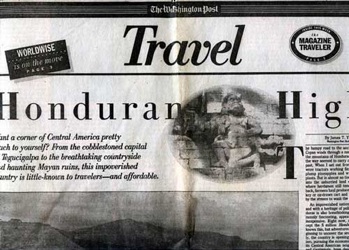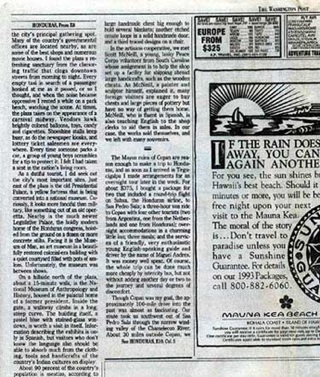Scott McNeill Art, “Honduran High,” The Washington Post, 1993
Honduran High
The Washington Post
March 7, 1993
...Traveling in a Third World nation is not always comfortable, but it often can be very interesting, and I was simultaneously appalled and delighted by glimpses of everyday Honduran life in the city and countryside. Honduras ranks with Haiti and Bolivia as one of the poorest nations of this hemisphere, and on the road to Copan I saw many people living in the humblest of mud wattle huts, topped with thatch and sometimes having only a curtain for a door…
...Though Tegucigalpa has a population approaching 1 million, the city disappeared as we climbed into a cool, scenic realm of green hills and tall pines. Every mile or two, a farmer had set up a stand to sell fresh flowers or vegetables, pine apples and other fruit. Outside many homes, the family laundry lay drying on fences and bushes.
Efforts have been taken to maintain the 16th-century look of Valle de Angeles to attract tourists, and the first person we saw as we approached the town was a mounted cowboy headed our way. Behind him three donkeys browsed the cobblestone streets for blades of grass. Sure enough this must be the 16th century, just 45 minutes outside Tegucigalpa. The village has a shady green square, with a white washed church at one end and a modest Municipal Palace at the other. On the sidewalk, a woman fried empanadas, a Latin American meat pie, over a charcoal grill.
About a dozen artisan shops are located in the village, including a small woodcarving factory with a dirt floor and rusted tin roof where eight workers sent the chips flying. One young man was carving a floral design on a large handmade chest big enough to hold several blankets; another etched ornate loops in a solid handmade door, and a third traced designs on a chair.
In the artisan cooperative, we met Scott McNeill, a young lanky Peace Corps volunteer from South Carolina whose assignment is to help the shop set up a facility for shipping abroad large handicrafts, such as wooden chests. As McNeill, a painter and sculptor himself, explained it, many foreign visitors are eager to buy chests and large pieces of pottery but have no way of getting them home. McNeill, who is fluent in Spanish, is also teaching English to the shop clerks to aid them in sales. In our case the works sold themselves, and we left with many souvenirs.










